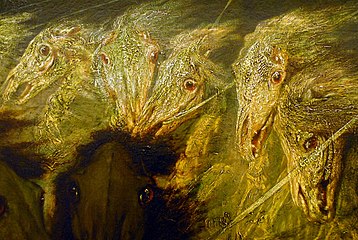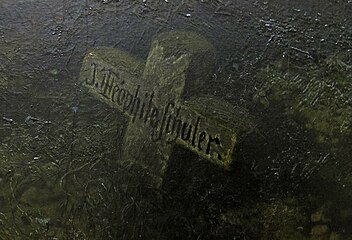The Chariot of Death
| The Chariot of Death | |
|---|---|
| French: Le Char de la Mort, German: Der Todeskarren | |
 | |
| Artist | Théophile Schuler |
| Year | 1848–1851 |
| Medium | oil paint on canvas |
| Movement | Romanticism |
| Subject | Death |
| Dimensions | 190 cm × 355 cm (75 in × 140 in)[1] |
| Location | Unterlinden Museum, Colmar |
| Accession | 1862 |
The Chariot of Death is a large allegorical painting by Théophile Schuler. It was gifted to the Unterlinden Museum by the artist in 1862. Its inventory number is 88.RP.454.[2] The painting is considered one of the most emblematic of the collection (which includes the world-famous Isenheim Altarpiece).[3][4] A drawn copy of the painting is kept in the Cabinet des estampes et des dessins.[5]
Content[edit]
The painting was begun by Schuler (then 27 years old) after his return to his hometown of Strasbourg, under the impression of the Revolutions of 1848, specifically the French Revolution of 1848, which he had witnessed in Paris. Schuler worked on its completion until 1851, during which time he became witness to the counter-revolutionary backlash, which confirmed the pessimism and the anguish of his vision of the 1848 upheavals and turmoil.[3][6]
The Chariot of Death is inspired by medieval and early Renaissance Dances of Death, especially Hans Holbein the Younger's. As with older depictions, Schuler's painting shows people from all ages and walks of life: a pope, a king, a young mother (modelled on the artist's sister), a fool, a poet, a sick man, a lawyer, a murderer, a Native American, an Arab, a young Napoleon... being taken away by death. A special emphasis is placed on artists (among them Dante and a self-portrait of Schuler), who are at the top of the pyramidal composition, and on French revolutionaries, with whom Schuler had empathized.[3][5][6]
Schuler depicts different personifications of Death: one is the angel of death in the centre of the painting, a young and beautiful but cold-faced woman with black hair and black wings, who drives the chariot while looking straight at the viewer; the other is a skeleton in a shroud, in the lower right corner of the painting, which is shown grabbing an executioner with its right hand, while dramatically driving the Wandering Jew (a common trope of anti-Judaism) away with its left hand.[1][6] On the opposite side of the diagonal starting bottom right with the Wandering Jew is a wayside cross, which the chariot is only driving by. Schuler thus raises the question of the meaning of death and alludes to the inability of religion to provide an answer.[7]
Gallery[edit]
-
The angel of death with her passengers
-
Death grabbing the executioner while sending the Wandering Jew away
-
Death's horses
-
Closer view of Death's white horses, showing the intense brushwork
-
The painter's signature on a grave cross
See also[edit]
- The Triumph of Death, painting by Pieter Bruegel the Elder
Bibliography[edit]
- Emmanuel Honegger: Le Char de la mort, Le Verger Éditeur, Barr, June 2020, ISBN 978-2-84574-360-1
References[edit]
- ^ a b Delcourte, Benoît (April 2016). Le musée Unterlinden - Guide des collections. Paris: Éditions Artlys. pp. 186–187. ISBN 978-2-85495-625-2.
- ^ "Le Char de la Mort". Joconde. Retrieved 29 April 2021.
- ^ a b c "The Maison – Schuler, Rouault, Monet" (PDF). Unterlinden Museum. Retrieved 29 April 2021.
- ^ "Le Nouvel Unterlinden" (PDF). archilovers.com. Unterlinden Museum. Retrieved 29 April 2021.
- ^ a b "La mort emportant sur son char toutes les conditions humaines". Joconde. Retrieved 29 April 2021.
- ^ a b c Susset, Valérie (10 September 2020). "Décrypt' art : «Le char de la mort» de Théophile Schuler (1848-1851)". Le Républicain Lorrain. Retrieved 29 April 2021.
- ^ Clément, Jean-Louis (27 July 2020). "Emmanuel Honegger, Le Char de la mort Jules-Théophile Schuler 1821-1878, Illkirch-Graffenstaden, Le Verger Éditeur, 2020, 72 p." Revue Politique et Parlementaire. Retrieved 30 April 2021.
External links[edit]
![]() Media related to The Chariot of Death at Wikimedia Commons
Media related to The Chariot of Death at Wikimedia Commons
- Presentation of the painting Archived 2021-04-29 at the Wayback Machine on the museum's website





